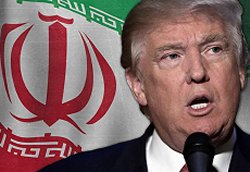
|
- Iran: Eight Prisoners Hanged on Drug Charges
- Daughter of late Iranian president jailed for ‘spreading lies’ - IRAN: Annual report on the death penalty 2016 - Taheri Facing the Death Penalty Again - Dedicated team seeking return of missing agent in Iran - Iran Arrests 2, Seizes Bibles During Catholic Crackdown
- Trump to welcome Netanyahu as Palestinians fear U.S. shift
- Details of Iran nuclear deal still secret as US-Tehran relations unravel - Will Trump's Next Iran Sanctions Target China's Banks? - Don’t ‘tear up’ the Iran deal. Let it fail on its own. - Iran Has Changed, But For The Worse - Iran nuclear deal ‘on life support,’ Priebus says
- Female Activist Criticizes Rouhani’s Failure to Protect Citizens
- Iran’s 1st female bodybuilder tells her story - Iranian lady becomes a Dollar Millionaire on Valentine’s Day - Two women arrested after being filmed riding motorbike in Iran - 43,000 Cases of Child Marriage in Iran - Woman Investigating Clinton Foundation Child Trafficking KILLED!
- Senior Senators, ex-US officials urge firm policy on Iran
- In backing Syria's Assad, Russia looks to outdo Iran - Six out of 10 People in France ‘Don’t Feel Safe Anywhere’ - The liberal narrative is in denial about Iran - Netanyahu urges Putin to block Iranian power corridor - Iran Poses ‘Greatest Long Term Threat’ To Mid-East Security |
Monday 09 May 2011Private banks open to assist Tehran insiders
IIn Tehran’s more exclusive neighbourhoods, branches of new “privately owned” banks seek to outdo each other as they display placards proclaiming that they will open soon. “More bank branches than grocery stores!” reads a headline in Tabnak, a conservative news website. The new banks include Ansar and Mehr, both affiliated to the Basij militia, the voluntary arm of the elite Revolutionary Guards, according to a conservative newspaper. It says that Shahr, another new bank, is linked to the municipality of Tehran, while Hekmat Iranian has ties to the army and shareholders of Day are family members of martyrs in the Iran-Iraq war. The openings mean that there are now eight state-owned banks and 18 privately owned banks in Iran. Eight have been established in the past year alone. But bankers and economic analysts say that the proliferation of new institutions reflects neither growth in the real private sector nor any improvement in Iran’s economy. For the past three years the central bank has refused to issue economic growth statistics, apparently because they are embarrassingly low. The International Monetary Fund has forecast Iranian non-oil gross domestic product to contract in 2011. “The new so-called private-owned banks are merely financial institutions for the regime loyalists as each group tries to be independent of other state bodies in their expansion of economic power,” says an economist, who asked not to be named. Most of the new banks are “public non-governmental institutions” that fall, directly or indirectly, under the authority of Ayatollah Ali Khamenei, Iran’s supreme leader and the country’s ultimate power. “This so-called ‘public non-governmental institutions’ sector, which is not envisaged in the constitution to have economic activities, is now bigger than the private sector and the government sector, excluding oil but including electricity and all industries and mines,” says one consultant. “They are becoming bigger and bigger and naturally they need their own financial instruments.” The central bank’s stance on the new institutions is not clear. After nationalising 37 banks during the 1979 revolution, it relented and licensed six private sector institutions about 10 years ago. The central bank declined to comment on the latest openings to the Financial Times. Bankers say that the six private sector banks have now been largely taken over by institutions linked to the regime. The proliferation comes despite a tough operating environment. Iranian banks generally struggle with undercapitalisation, a shortage of professional personnel, poor risk management and weak internal audit systems as well as restricted access to the global financial system. In 2007 the UN and the US, joined later by the European Union, began targeting Iranian banks for their alleged financial assistance to nuclear and missile programmes. Now some state and quasi-state-owned institutions including Melli, Mellat, Saderat and Sepah face international sanctions But the bigger concern is over non-performing loans, which the central bank puts at IR420,400bn ($41bn). Some parliamentarians claim the real figure is $47.6bn. This represents a tenfold increase since 2005, when Mahmoud Ahmadi-Nejad swept to power and promised cheap bank loans to the poor. Analysts believe many Iranian banks are technically bankrupt because of the bad loans, largely owed by state-owned companies or business tycoons. “If your doubtful loans are above 2 per cent, you are in trouble. But ours are above 20 per cent, which means all state-owned and private banks – other than the new ones – are bankrupt,” says a senior banker who asked not to be named. However, no bank in Iran has been declared insolvent, while all claim they are making good profits. There is suspicion about the way the profits are arrived at. “Bank A tells Company B: ‘Now that you cannot pay back your loans, give us a promissory note to ensure you’ll pay the 25 per cent interest’. That paper is added to the bank’s calculations as profits and this is repeated every year,” says a second banker. Nonetheless, banks are the main channels to secure money for industrial projects. They can charge interest rates of more than 30 per cent. The latest central bank figures suggest liquidity grew by about 24 per cent in the first nine months of the last Iranian year, which may explain why there are so many applicants for banking licences. Copyright The Financial Times Limited 2011. You may share using our article tools. Please don't cut articles from FT.com and redistribute by email or post to the web. Source: http://www.ft.com/cms/s/0/ebcda530-7a5a-11e0-af64-00144feabdc0.html?ftcamp=rss#axzz1LsojrPvh |






